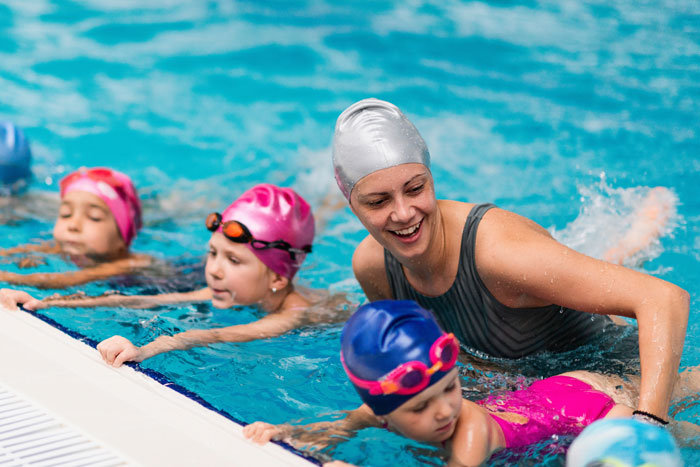Most of us are drawn to water, whether we want to immerse ourselves in it or simply engage with it from dry land or boats. And for children, water can be particularly alluring. But whether it’s a pool, pond, river or ocean, water can quickly become dangerous, so it’s imperative to be equipped with basic swimming and water safety skills. Fortunately, many organizations and communities are working to remove barriers to learn-to-swim programs and educate as many people as possible, both children and adults.
We’ve shared these statistics before, but the sobering numbers bear repeating; according to the Centers for Disease Control and Prevention (CDC), more children ages 1 to 4 die from drowning than any other cause of death. And it’s the second leading cause of unintentional injury death for kids ages 5 to 14.
The YMCA of the USA is one organization dedicated to shrinking these numbers. “On a national level, the YMCA works with
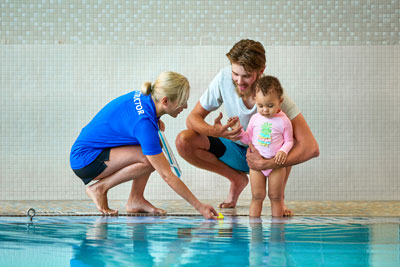
national partners, private funders, private partners and federal agencies to provide access to swimming lessons”, said Lindsay Mondick, director of aquatic safety with YMCA, who mentioned two current projects with the CDC focused on swim lesson access.
And on a local level, many Ys work with community-based organizations to bolster swim lesson access. “We believe that teaching children how to be safe around water is not a luxury, it’s a necessity.”
The YMCA introduced the country to group swimming lessons more than 100 years ago, in 1909, and now they teach more than 1 million children water safety and swimming skills every year. Their Safety around Water program provides children of all ages and backgrounds with the essential tools they need to be confident in and around water, according to Mondick, which can “open a world of possibilities for them to satisfy their curiosity safely. The program is unique in that it specifically targets youth, particularly those from African-American and Hispanic communities, who are at the highest risk of drowning.”
The Safety around Water program consists of eight lessons, focusing on technical skills while also weaving in fun activities. It’s offered at no cost to most participants, according to Mondick, which is critical when it comes to including larger populations. A survey conducted by the Y found that while nine out of 10 parents see swimming as a key life skill for kids, three in 10 say that affordability hinders their ability to prioritize water safety lessons for their kids. “YMCAs also have financial assistance for the YMCA swim lesson programs,” added Mondick.
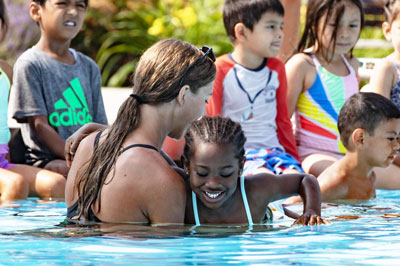
The American Red Cross website reports that 79% of children in households with incomes less than $50,000 have few to no swimming skills. Juliene Hefter, executive director and CEO of the nonprofit Association of Aquatic Professionals (AOAP), described the association’s swim lesson grant program, which member organizations can apply for. If chosen, the grant “provides lessons free of charge, or at a discounted rate, for numerous children throughout their communities. Other groups such as the USA Swimming Foundation, the Step into Swim program (administered by the Pool & Hot Tub Alliance), U.S. Masters Swimming, British Swim Schools and the Hope Floats Foundation, plus many other nonprofits and local communities, provide scholarships for swim lessons.”
Hefter went on to explain how the aquatics industry as a whole has taken a huge hit over the past four years, with “a lack of qualified staff and pool time available to teach the enormous amount of children to swim that we need to. You hear stories all the time from parents trying to get their children into swim lessons, and when registration opens it seems that the open spots fill up almost instantaneously.” And as a lot of registrations are done online, families without computers or access to home internet are left out, she added.
Dawn Rachjaibun is the program manager of aquatics for the city and county of Broomfield, Colo., and she reported that all of their classes are full and have waitlists. “We’re constantly doing our best to hire and train more instructors so that we may offer more swimming lessons.” She said they have an aid program established and “accept applications for scholarships for our swimming lessons and all of the programs that we offer in recreation. They’re based upon financial need.”
Lessons in Broomfield take place indoors at two facilities, seven days a week, and some private lessons are offered outdoors in
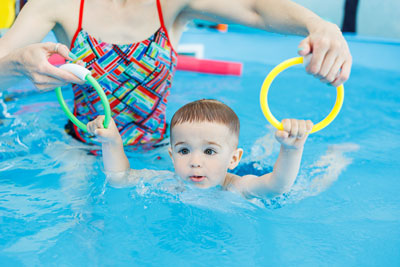
summer. “We currently certify our instructors through the American Red Cross using their established learn-to-swim curriculum,” said Rachjaibun. “We have instructor trainers that have become certified to teach the Water Safety Instructor class (for those 16 and over), then we hold certification classes in-house for staff to take to become certified as Water Safety Instructors.”
There’s also ongoing training and support, according to Rachjaibun, including in-service training and practice sessions where tips and tricks are given to help participants become better instructors. “We review stroke corrections and feedback, how to help them with keeping the kids engaged, and we perform observations where we watch instructors teach and then give them feedback to help them.”
They also offer in-house training for 15-year-olds, offering a water safety aide class where they “learn how to teach all the basic skills, including water safety, teaching water adjustment skills, floats, kicking, blowing bubbles, basic arm strokes and breathing, and backstroke,” said Rachjaibun. They then shadow certified instructors during classes, helping with pool safety and “keeping the kids engaged, having fun, supported, organized and safe.”
Learn-to-swim classes for all ages and levels are offered in Broomfield, and this includes parent-child classes for children ages 6 months to 3 years, which Rachjaibun said are incredibly popular. A parent/caregiver must be in the water, and the instructor teaches them how to teach their child the basics of water adjustment, safety and basic swimming fundamentals. “Learning to love the water, respect the water and have fun in the water at a young age is key to learning how to swim.” Additionally, there are teen and adult swim lessons offered. “There’s a huge demand for them, and we’re doing our best to offer opportunities at night and on weekends.
“We also offer private lessons or one-on-one classes as well as small group classes—1:3 ratio—for kids that have a disability and need more focused attention,” continued Rachjaibun. “We also offer mainstreaming opportunities in our regular group classes and then have an aide with the class to help out.” She said they also have a Special Olympics swim team that participates in the state’s Special Olympics program.
Mondick pointed out that individuals with disabilities face a higher risk of drowning, including those with autism, who are 160
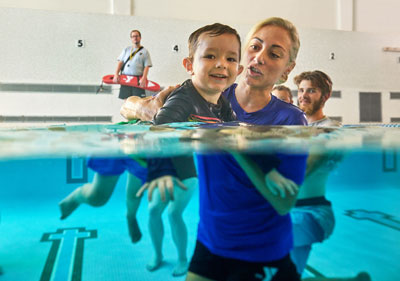
times more likely to die from drowning compared with the general population. To support these individuals, the YMCA has created “instructor tools and resources like visual cards, visual schedules and social stories that YMCA swim lesson instructors can use every day in their programs. Y-USA has also made formal training opportunities in this space available in the form of instructor training modules and templates for aquatic leaders to facilitate in-services for their staff,” said Mondick.
When it comes to adaptive swim lessons, Hefter said it’s an area that’s been greatly needed in the aquatics industry, and more programs are being developed to address this concern. “For example, Swim Angelfish has an amazing program available called adaptive Swim Whisperers. They also provide an abundance of resources for swim instructors and families as well. They specialize in working with individuals who have autism, anxiety, sensory needs, motor challenges or those who learn differently.”
In addition to providing adaptive swim lessons, Swim Angelfish offers adaptive professional training, both online and in-person. They’ll help lesson providers create adaptive swim or aquatic therapy programs. They offer interactive in-water training workshops for aquatic pros to advance their adaptive aquatics skills and knowledge, which they believe will contribute to reducing drowning statistics. And they offer an adaptive Swim Whisperers online certification program.
Over the past 35 years, the U.S. Swim School Association (USSSA) has grown to become the largest swim school association in the country, representing all learn-to-swim programs. Lisa Zarda is executive director, and she mentioned an online course they offer as an excellent resource for those who teach children and adults with special abilities. “The bonus is that tips shared in these courses can also be helpful when working with all types of swimmers. In addition, this training is helpful for those times when a swim instructor might have a child with undiagnosed special abilities in their swim class.”
USSSA works to “build and strengthen relationships” among members, promoting a “vibrant exchange of ideas and support
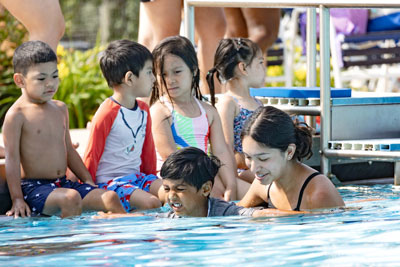
within our community,” said Zarda. They present workshops and conferences and offer a Certified Fundamental Swim Instructor (CFSI) national certification program, which includes online education, verification of in-water training, CPR certification and a background check. “The CFSI works to standardize the basics in areas such as emergency preparedness, student safety, harassment and abuse prevention, class management, working with frightened children and adults, the importance of breath control, buoyancy and movement, as well as tips for teaching adults and special abilities.”
And are a lot of adults taking swim lessons? Zarda said yes, and pointed out that April is Adult Learn to Swim Month. “We advocate that it’s never too late to learn to swim, and if someone has been thinking about it, they should reach out to swim schools and programs in their area to learn more. There are some programs that even specialize in working with adults that have a fear of the water.”
U.S. Masters Swimming—in partnership with the USA Swimming Foundation—offers adult learn-to-swim grant opportunities. Hefter said it’s imperative to ensure that adults have swim lesson access, for enjoyment, to learn lifesaving skills and “so they know the value of lessons for their children as well.” In fact, a study by Pediatrics and Adolescent Medicine found that if a parent doesn’t know how to swim, there’s only a 19% chance that a child in the household will learn to swim. Additionally, more than one-third of American adults can’t swim the length of a pool, according to the CDC.
The YMCA offers adult and teen swimming lessons for beginners or those who have a fear of the water, and Mondick said there’s been a trend for adults learning to swim, with many Ys offering financial assistance to adults for lessons. “Oftentimes, adults who have children or grandchildren in swimming lessons commit to learning to swim.”
And while the YMCA continues to offer their nationally recognized Swim Instructor certification, they also offer continuous training and innovate new ideas and methods. This summer, the Y is launching a new module called YMCA Swim Lesson Instructor: Teaching Techniques for Building Aquatic Trust, focused on helping instructors understand that trust is an essential component in learning, because for many, the water is a scary place. “Anxiety and trauma can impact learning to swim, and when trust is present and thriving, students and teachers experience more successful teaching and learning experiences,” said Mondick.
In Illinois, the Fox Valley Park District (FVPD) serves more than 236,000 people. They operate Parkers Swim School, to
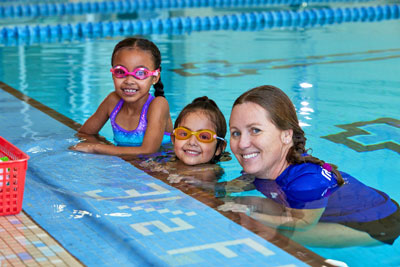
“introduce the fundamental lifesaving skill of swimming at an early age,” according to Aquatics Program Manager Viktoria Orosz, with kids as young as 6 months experiencing a comprehensive program with progressive instruction at every level. Lessons are offered at three locations, and instructors are trained in-house through a program based on their lesson curriculum, to “provide consistency between instructors
and levels.”
In addition to group classes, semi-private lessons are offered for similar skill levels, and “Our private lessons are popular to kind of fast-track participant skills,” said Orosz. She said their adult lessons are popular, believing that “everyone should know how to swim, at least on a safety level. The adult lessons are special to me because our participants may not have had the opportunity to attend swim lessons when they grew up, or they would like to refresh their skills.” It’s also a great example for peers and other age groups.
Orosz said they participate in the World’s Largest Swimming Lesson, an annual drowning prevention initiative created by the World Waterpark Association in 2010 to stress the importance of swim lessons. “This event is free of charge, and we can accommodate approximately 100 participants of any age for a free swim lesson on a first come first serve basis,” which typically reaches the maximum participants.
To include all populations, Orosz explained that they work closely with the Fox Valley Special Recreation Association (FVSRA). “FVSRA does an hour-long training session for our staff yearly so we can provide a quality experience for all participants. Moreover, they have an inclusion process where they do assessments of participants who need inclusion services and based on their assessment, they may provide a companion to ensure the success of the participants in (our) programs.”
FVPD has a scholarship program that’s available to all district residents who qualify for assistance and where registration fees may be required. “We have numerous families attending swim lessons by using their scholarship funds,” said Orosz. And there’s a swim lesson grant program alongside two local school districts. “We offer a session of swim lessons for each school’s second grade students where they can attend the program at no cost to the families. We hope that… over time we can achieve that every second grader will have swim lesson experience and can feel safer around any body of water.”
In fact, Hefter said that more communities and states are requiring children to participate in swimming lessons through school districts. Florida passed legislation in 2021 requiring schools to provide parents and guardians with information explaining the importance of lessons, and have since passed the Every Child a Swimmer law. Georgia, Arkansas and Louisiana have passed laws to promote swim lessons for all children, and Minnesota is considering such, according to Hefter.
Zarda said they’ve seen increased efforts in the promotion of dry land drowning prevention education, an “exciting development” as another layer of protection. “Kids are sponges and can learn important information and tips that could help save them in the future.” She mentioned the dry land curriculum offered by Stop Drowning Now as a great resource for teachers who want a ready-to-use lesson plan on water safety
education.
USSSA also does legislative work, recently launching lobbying efforts in select states and furthering proactive initiatives aimed at fostering relationships with policymakers, regulators and other pertinent stakeholders. “This proactive engagement is important in our industry, where standards are still evolving,” said Zarda. “Our participation ensures that advocates for learn-to-swim programs have a voice in shaping practical, effective and beneficial emerging standards.”
And there are always new technologies being adapted to learn-to swim efforts, including virtual reality swimming simulators, mirrors on pool bottoms and training devices that attach to swim goggles and collect data. Underwater cameras and Artificial Intelligence (AI) software allow for swim analysis, which can also be accomplished using a smartphone and AI software. Many swim apps are available aimed at helping swimmers of all levels.
Back in Colorado, Rachjaibun discussed COVID and the lingering impact it had on the aquatics industry, noting that many have struggled since then to stay afloat and continue to offer their programs. “We understand the need to learn to swim and we want to help keep kids safe.” And she stressed that even if a child can swim, it’s important for parents to be supervising their children in and around water. “Children and people are not drown-proof; accidents can always happen.” RM



